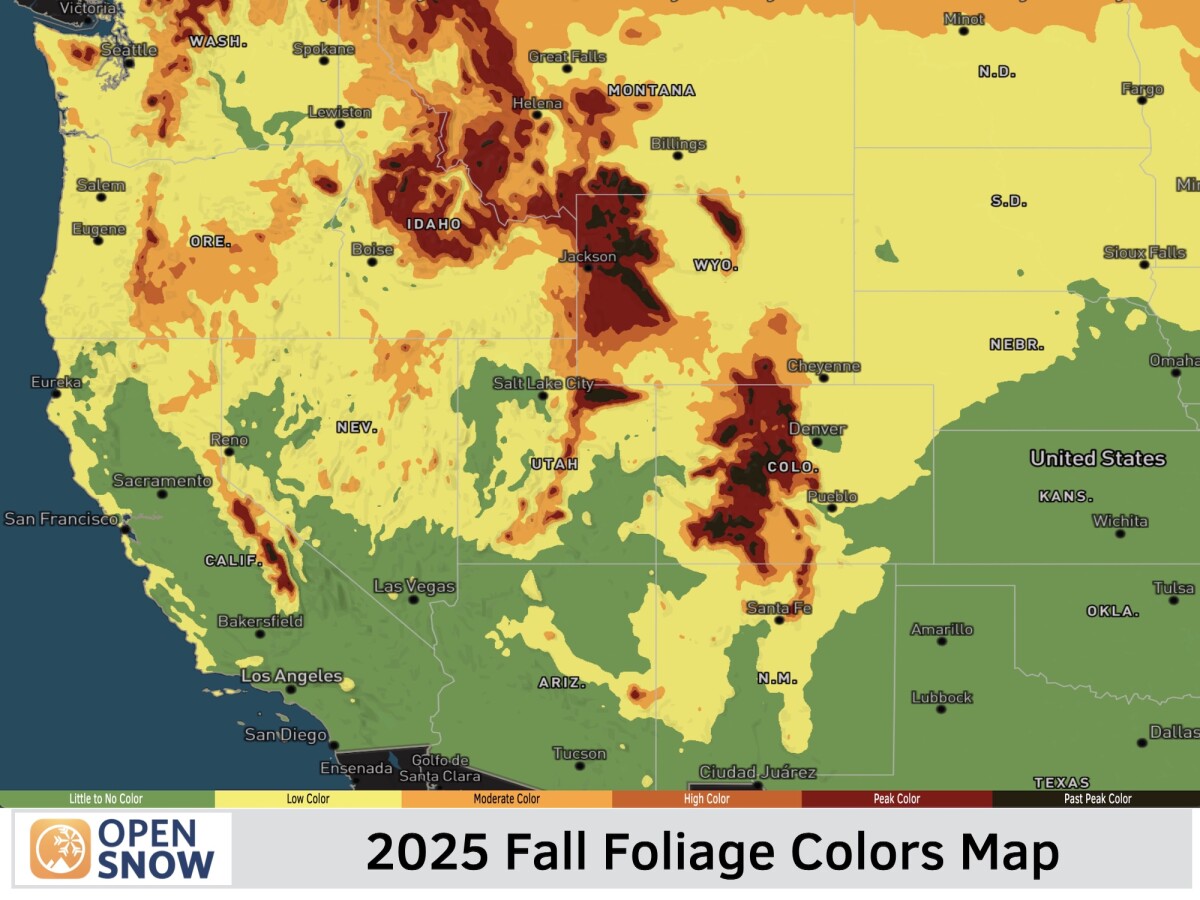News

By Luke Stone, Forecaster Updated 6 months ago January 9, 2025
Santa Ana Winds, Explained
Downslope winds, known in Southern California as Santa Ana winds, play a major role in wildfire activity and impact the region's weather, climate, and environment in a variety of ways.
Santa Ana winds pose aviation hazards, lead to oppressive temperatures, worsen allergies, cause damage to infrastructure and utilities, and can result in dangerous driving conditions. Santa Ana winds have been observed and documented for over one hundred years, and remain an important research topic in the region. The various impacts of Santa Ana winds will be explored below.
What is the mechanism of Santa Ana winds?
Santa Ana winds in Southern California cause dramatic temperature increases, decreased humidity, and strong winds. They typically develop when a high-pressure system develops over the Great Basin, a large area of high desert that encompasses much of Nevada and parts of Utah and surrounding states. These high-pressure systems usually form in the autumn and winter months but can occur at any time of the year.
Concurrently, a low-pressure system often forms off the coast of Southern California or over the Pacific Ocean. The pressure difference between the high-pressure system over the Great Basin and the low-pressure system along the coast creates a strong pressure gradient.

Image: Schematic of Santa Ana winds. Courtesy of the National Weather Service.
The pressure gradient drives air from the high-pressure area in the east towards the low-pressure area in the west, resulting in winds that flow from the inland deserts towards the coast. As the air masses move westward, they descend from higher elevations of the interior mountains and deserts. The descent causes the air to compress and warm, leading to hot and dry conditions.

Image: Schematic of Santa Ana winds flowing from the High Pressure over the Great Basin toward the low pressure off the California coast. Courtesy of Paul Duginski.
The topography of Southern California, with narrow passes and canyons, can act as natural wind tunnels, accelerating the wind speeds as they move towards the coast. The combination of the downslope and gap wind effects creates intense winds in this region.

Image: Schematic of Santa Ana winds flowing away from an area of high pressure through the desert and mountain gaps toward the Pacific Ocean. Courtesy of Judson Jones.
Wildfires
Santa Ana winds have a profound impact on wildfire activity in Souhern California. These winds and associated conditions can exacerbate a fire in a number of ways. The descending air on the lee side of the mountains warms rapidly and loses much of its moisture, leading to low humidity levels. Combined with the narrow mountain gaps and canyons, the downslope winds can reach very high speeds.
Santa Ana winds drastically reduce humidity levels, allowing vegetation to rapidly dry out. This process transforms grasses, shrubs, and trees into highly combustible materials. Moisture near the surface raises the ignition temperature of vegetation, preventing faster spread of fires. Santa Ana winds eliminate nearly all of the moisture in the air near the surface, increasing the speed at which wildfires can spread. The winds also prevent temperatures and relative humidity from recovering overnight, which is typically a time when firefighters can get a better handle on fires.

Image: Schematic of the Santa Ana winds mechanism. Courtesy of Paul Horn.
These hot, dry, and strong winds are a critical factor in the rapid spread of wildfires. The winds can carry embers long distances, igniting new fires far from the source. This behavior significantly complicates firefighting efforts as the fires spread more rapidly and burn more intensely.
Several large and destructive wildfires in recent years have been exacerbated by Santa Ana winds, fueling some of the most devastating wildfires in California's history. The Cedar Fire (2003), Witch Creek Fire (2007), Thomas Fire (2017), Old Fire (2003), Laguna Fire (1970), and Woolsey Fire (2018) are some of the worst Santa Ana wind-driven fires and are summarized below.
The Cedar Fire (2003)
- Location: San Diego County
- Acreage Burned: Over 273,000 acres
- Homes Destroyed: More than 2,800
- Fatalities: 15 people
- Details: The Cedar Fire, ignited by a lost hunter's signal fire, was exacerbated by Santa Ana winds, quickly spreading across San Diego County. It remains one of the largest and most destructive fires in California's history.



The Witch Creek Fire (2007)
- Location: San Diego County
- Acreage Burned: Approximately 197,000 acres
- Homes Destroyed: Around 1,650
- Fatalities: 2 people
- Details: The Witch Creek Fire, driven by strong Santa Ana winds, merged with other fires, creating a massive firestorm that swept through San Diego County, leading to extensive evacuations and widespread destruction.
The Thomas Fire (2017)
- Location: Ventura and Santa Barbara Counties
- Acreage Burned: Over 280,000 acres
- Homes Destroyed: More than 1,000 structures
- Fatalities: 2 people
- Details: Initially sparked by power lines, the Thomas Fire quickly grew under the influence of fierce Santa Ana winds. It became the largest wildfire in California's modern history at the time and led to significant property damage and evacuations.



The Old Fire (2003)
- Location: San Bernardino County
- Acreage Burned: Around 91,000 acres
- Homes Destroyed: Over 1,000
- Fatalities: 6 people
- Details: The Old Fire, suspected to be arson, was driven by Santa Ana winds through densely populated areas in and around San Bernardino, causing extensive destruction and loss of life.
The Laguna Fire (1970)
- Location: San Diego County
- Acreage Burned: Approximately 175,000 acres
- Homes Destroyed: Over 382
- Fatalities: 5 people
- Details: The Laguna Fire, also known as the Kitchen Creek Fire, was driven by strong Santa Ana winds. It rapidly spread across the region, fueled by dry conditions and heavy winds, becoming one of the largest fires of its time.
The Woolsey Fire (2018)
- Location: Ventura and Los Angeles Counties
- Acreage Burned: About 97,000 acres
- Homes Destroyed: Over 1,600 structures
- Fatalities: 3 people
- Details: The Woolsey Fire, ignited under conditions of strong Santa Ana winds, swept through parts of Malibu and other areas, causing widespread damage and leading to significant evacuations.
Infrastructure
Santa Ana winds can damage buildings, residential and commercial structures, and other property and infrastructure. These winds have reached speeds over 90 mph, with gusts exceeding 160 mph on one occasion. They can cause structural damage to buildings, particularly those not designed to withstand such forces. Both residential and commercial structures with weak reinforcement are susceptible to damage. Roofs can be marred or blown off, windows can shatter, and weaker structures may collapse.
The winds can pick up and hurl debris, including tree branches and outdoor furniture, which can break windows and damage walls and roofs. Debris carried along by Santa Ana winds can lead to the failure of protective building envelopes, siding, or walls. Below are images from a strong Santa Ana wind event in Orange, CA in 2003.





Utilities
Falling trees, tree branches, and other debris cause a variety of problems with utilities. Trees and tree branches have been a major cause of power outages in the region, knocking down power lines. Tree limbs breaking in winds of only 45 mph can be thrown over 75 feet. Overhead power lines can be damaged even in relatively minor Santa Ana events. High winds can knock down utility poles, leading to widespread power outages. These outages can disrupt daily life, business operations, and critical services such as hospitals and emergency responders.
Transportation Hazards
Santa Ana winds impact transportation in a variety of ways in Southern California. These winds create several challenges for road, air, sea, and rail travel, posing risks to safety and causing significant disruptions.
The strong gusts of Santa Ana winds can make driving hazardous, particularly for high-profile vehicles like trucks, buses, and recreational vehicles. These winds can cause vehicles to swerve or tip over, leading to accidents and road closures. Blowing dust and debris can reduce visibility on highways and roads, increasing the risk of collisions.
High winds can complicate airplane takeoffs and landings, leading to flight delays and cancellations. Santa Ana winds often batter the north coast of Santa Catalina Island, including Avalon Cove and the island's airport. The winds can also create choppy waves, leading to hazardous boating conditions. They tend to make for choppy surf conditions in the Southern California Bight. Similar to roads, railways can be obstructed by fallen trees and debris. This can delay train services until the tracks are cleared.
Health
Santa Ana winds pose several different health problems to the region. They stir up dust, pollen, and other particulates, which can exacerbate respiratory conditions such as asthma, bronchitis, and chronic obstructive pulmonary disease. Individuals with pre-existing respiratory conditions are particularly vulnerable to these airborne irritants.
Summary
Santa Ana winds are a powerful and influential weather phenomenon in California that flows from the inland desert regions toward the coastal areas of Southern California. These winds can pose serious risks to communities in their path, including power outages, downed trees and power lines, transportation hazards, infrastructure damage, and increased wildfire danger. Understanding their characteristics and effects is crucial for effective preparation and response, particularly as climate change may influence the frequency and intensity of these winds. The affected areas must continue to improve forecasting, increase public awareness, and expand strategic mitigation efforts to better manage the challenges posed by Santa Ana winds.
Luke Stone
Forecaster, OpenSnow
About The Author




